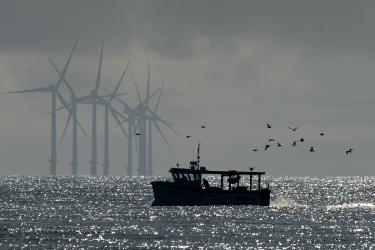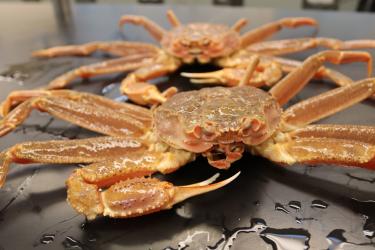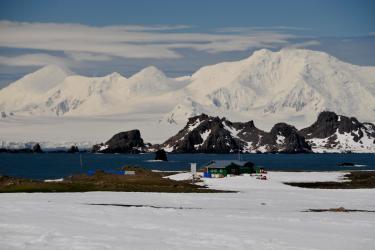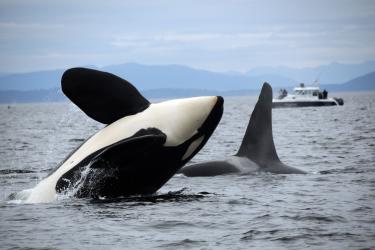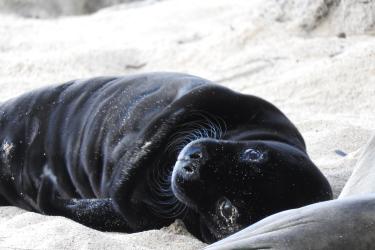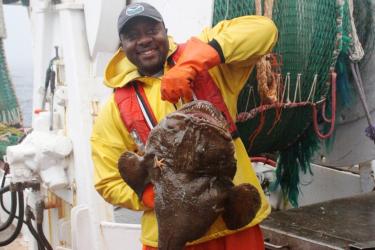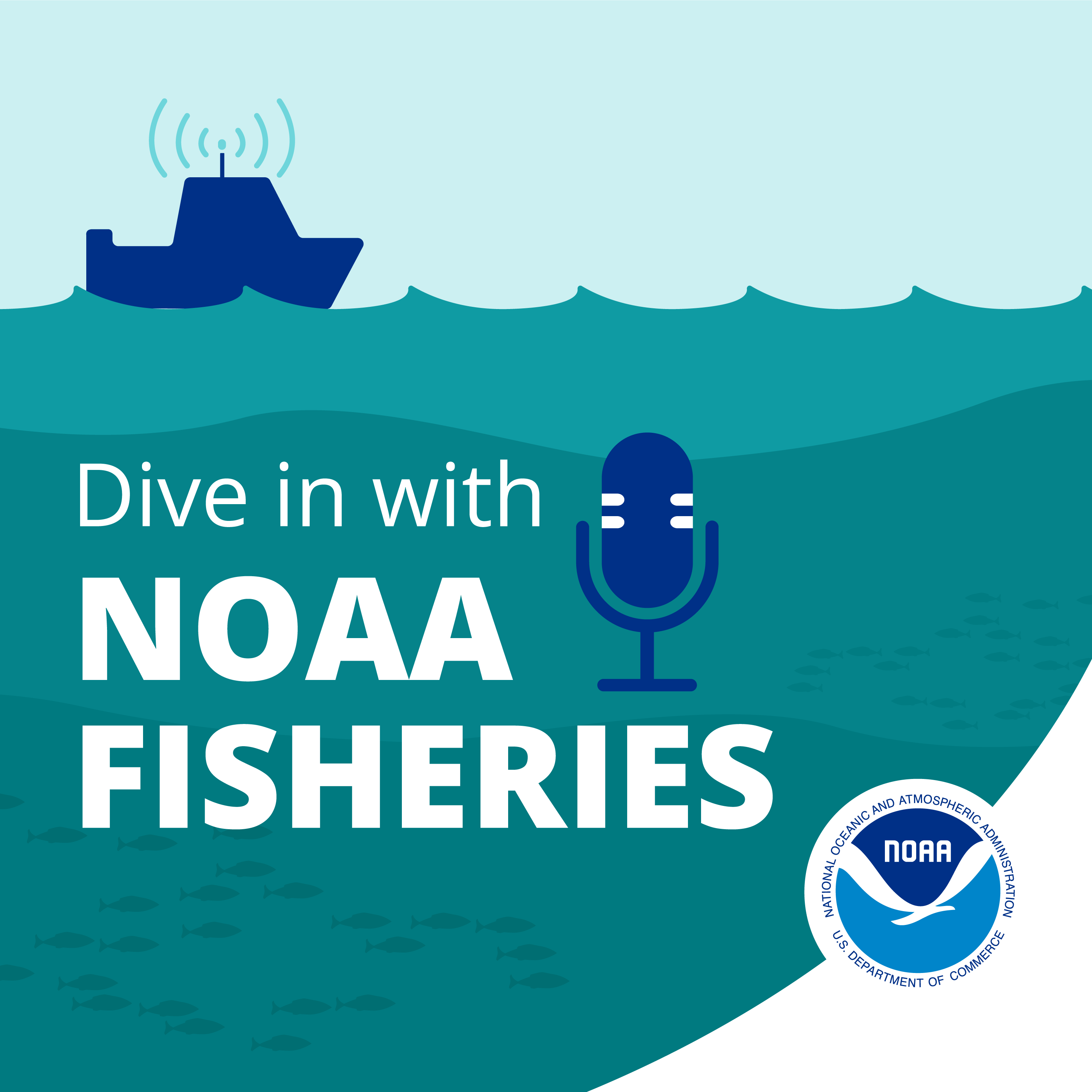Studying Sound in the Ocean to Prepare for Offshore Wind Development
0:00:01.6 John Sheehan: Moving the nation toward renewable energy and away from fossil fuels is a big priority for the Biden administration. And a key piece of the strategy to get there is generating more offshore wind energy.
[video playback]
0:00:28.4 JS: This is Dive In with NOAA Fisheries, I'm John Sheehan, and today we'll hear about a new study that recorded the sounds of the ocean off of southern New England as a means to prepare for and predict the impacts of offshore wind developments. Using passive acoustics or underwater recorders, the study measured ambient sounds, fish and marine mammal activity, vessel occurrences, and other noise that all makes up the region's soundscape.
0:00:54.0 Dr. Sofie Van Parijs: A soundscape contains everything from any kind of biological sound, could be marine mammals, seal, fish, or crustacean, as well as geological sounds, which could be like underwater earthquakes and includes anthropogenic sounds. Those are human-made sounds, and that can be anything from vessel noise to seismic surveys, pile driving, or echo sounders from a fishing boat.
0:01:22.1 JS: This is my guest, Dr. Sofie Van Parijs, an author of the study and the passive acoustics branch leader at NOAA's Northeast Fishery Science Center.
0:01:30.2 DP: We wanted to get some baseline data, and in our case, that is underwater recordings within the southern New England offshore wind energy area that was about to be developed. And to do that, we wanted to just get an understanding of what that area sounded like, what animals were present, what human sounds were present during the time prior to any construction or any other activities happening for offshore wind development.
0:02:00.4 JS: And obviously baseline meaning this is sort of what's in the area currently. This is what you can expect of ocean sound before any of the offshore wind. Construction took place.
0:02:13.0 DP: Yes, that's right. So baseline data collection is incredibly important. If you don't know what conditions you have beforehand, it's really hard to be able to show that anything's changed. Right. And so it's really important, particularly with things like offshore wind development, but also other activities, even climate change, right, that's occurring throughout our oceans, is to have an understanding of what your ocean looked like before so that you can then compare it to what you're then looking at in five years time or in 10 years time to look at how it may have changed.
0:02:47.0 JS: And this was the first such study to do this, particularly for multi-species identification, correct?
0:02:54.0 DP: Yes, that's right. Some of these studies have happened off in Europe, where offshore wind obviously has already been developed, but they don't have as many species as we do here, marine mammal species, particularly off the east coast of the US. So here we have a much larger cohort of different species and some really endangered ones like the North Atlantic right whale, for example.
0:03:15.4 JS: Yeah. What were the results of the study? What were you able to say is the baseline?
0:03:20.3 DP: We found that this area actually had eight species in one genus. So it has blue whales, fin whales, sei whales, North Atlantic right whales, minke whales, humpback whales, sperm whales, a whole suite of dolphins, and harbor porpoise. So it was just an incredibly rich and diverse area for marine mammals.
0:03:42.9 JS: Okay, so that has big implications because the areas that you studied are potential sites for offshore wind.
0:03:52.2 DP: Yeah, absolutely. And so our information is really important for managers because they can use it to look at when protected species are in the area and therefore mitigate the risk of offshore wind development.
0:04:04.0 JS: So in addition to being able to now more definitively say, these are the animals in this area and at what times. Are you able to draw inferences to how the noise impacts certain species?
0:04:19.3 DP: We are. We are able to at least look at the noise levels that are produced by some of these activities. So we can measure that from the acoustic recorders we've got. And we have some basic understanding as to if a sound is too loud, that it might impact the hearing of an animal, for example, if it's above a certain threshold. If it's below that, it might still actually affect the animal. It might cause behavioral changes, right? So it really depends on what the animals in the area are doing at the time and the noise levels as well as how often that sound is being produced.
0:04:58.2 JS: I see. And what can we say about the noise generated by offshore wind, either in operation or in sort of scouting locations? I know that sonar is often used.
0:05:12.0 DP: Yeah, I think the main thing with the sounds that offshore wind development produces is that they're really varied and there's all sorts of different sounds. There's the sonar that you're talking about, looking at the bathymetry, so what that kind of ocean floor looks like. There's all sorts of things like they move boulders around, they dig for cables, and so it produces just like a digger digging into the ocean. Or they'll often use a vessel when they try and keep themselves in place so they can put the pylon in or maneuver. And so that'll cause a lot of thruster noise, for example. And then during construction, obviously, there's the driving of the piles into the seafloor. Though one of the things when they are actually pile driving, one of the things that the managers require industry to do is to put these devices called bubble curtains around the pile driving area. And that does actually dampen the sound that is produced by the pile being driven into the seafloor.
0:06:10.0 JS: Really? What are bubble curtains?
0:06:12.3 DP: They're literally what they sound like. They're a circle with holes in it and air pushed through, and so bubbles come up, and it just dampens the sound that's able to get through those bubble curtains. Particularly, it dampens the higher-frequency sounds, but it also dampens some of the lower-frequency sounds. So it's a pretty effective mechanism for minimizing the amount of impact that these noises have.
0:06:41.2 JS: Oh wow, so it's like this active device that's pumping air down into this structure that then releases air through the water, it bubbles up through the water column, and that's able to dampen sound waves.
0:06:56.0 DP: Yes, absolutely. It's something they've used a lot in Europe when they were doing their wind energy construction. And similarly, we're using it here. And that's really the measure then is they want to make sure that the noise doesn't travel too far and isn't so loud that it could really impact any animals, marine animals that might be in the area.
0:07:16.3 JS: That is ingenious.
0:07:18.0 DP: Yeah, there's lots of cool and different technologies that have been developed to improve the ways in which they can build these type of wind turbines in the ocean and to improve to have the least impact possible as well.
0:07:33.0 JS: So from the study, are there any conclusions or maybe takeaways about what level of noise marine mammals can tolerate and what's being generated from current offshore wind activity?
0:07:46.5 DP: From the study that we did, really what you can mostly tell is what time periods activities like pile driving should not occur. For example, at the moment in the southern New England area, there is a time period from January through April where there is no construction allowed. And that's because, as you can see in our study, that is when there was the most greatest activity of North Atlantic right whales. So what we can do is just confirm that those time periods are accurate and appropriate. I think in terms of a lot of the other kind of impacts, that's going to come next. That's going to be the next part is when we start to evaluate what was really out there and what other sounds are there that we might need to look at and to add into our mitigation requirements.
0:08:33.1 JS: Passive acoustics are being used so much more. It's a really effective technology to monitor the ocean. I'm wondering what the future holds for the technology. Where do you see it being employed? What are some future possibilities for it?
0:08:49.2 DP: So there's, I think, many future possibilities for it. So passive acoustics really provides you with this lens into the ocean. So right now we use it a lot to understand distributional changes. When are animals in an area? Does that change over time? How with our changing oceans, with all these climatic changes, does that maybe vary? We're also though starting to use it for other applications. For example, we are using it to monitor protected areas that are closed to fishing at certain times and so you can use it to see whether there's been to enforce whether there's been any inroads into that. Has fishing occurred within a protected area outside of the time when it was being closed? So you can use it for some level of marine park enforcement as well. It can provide just a whole realm of different insights, right? It can show you not just marine mammals. It can tell you about fish spawning when fish are in a given area. It can tell you about crustaceans. It can tell you about wind and weather. And so it just provides this real kind of comprehensive look at ocean health.
0:09:57.5 JS: And as technology advances... The potentials for more real-time information is just growing. Right now, it sounds like a lot of it is sort of collected after the fact, but I think the potential is there for real-time communication with these devices.
0:10:16.0 DP: Yeah, and actually we're just putting together an Atlantic-wide real-time network. We have quite a few resources already out there that are monitoring in real time. In real time really is what it does is rather than having to go out and bring your data back before you can see what animals were in an area, you can use it to send back information usually via satellite phone or just a mobile phone link. And it provides you with an understanding of what different whale species or other species that you're interested in were in an area at the time. And we use that extensively for monitoring in real-time for North Atlantic right whales. We'll have either a mooring which is fixed in place but sending satellite information back or a glider which is moving around in the ocean sending back information and then as soon as we hear a right whale a notice to mariners will go out to alert them that there is an endangered species in the area and they should slow down and be cautious.
0:11:14.0 JS: That's so cool.
0:11:15.2 DP: It is, it's super cool and it's really becoming a hugely important tool. What we've seen. Most recently, as you can see, just the movements of these whales as they're moving up and down in real-time. And so what we've understood is just that they use different areas a lot more than we thought before, and they move between these areas a lot more. So that's super important when you're trying to mitigate vessel strike impacts. And so this gives you a much better understanding of just how they move around and when they stay in a certain area or when they move on to another one.
0:11:51.0 JS: Dr. Sofie Van Parijs, thanks so much.
0:11:53.4 DP: You're welcome.
0:11:55.0 JS: Dr. Sofie Van Parijs is the Passive Acoustics Branch Leader at NOAA's Northeast Fisheries Science Center and an author of the recent study that used passive acoustics to evaluate the potential impacts of offshore wind development. It is important to note that while passive acoustic monitoring has many benefits and is helping answer a lot of questions about marine mammals and human impacts, it does have limitations. For example, marine mammals can only be detected when they're vocalizing. Additional measures such as visual monitors, time and area restrictions, speed zones, and more are often necessary when trying to protect and reduce the impacts to marine life. And these are just some of the considerations NOAA scientists have to think about when we talk about offshore wind energy. After all...
0:12:43.0 Dr. Jon Hare: The development in the ocean intersects with all of our sort of core activities.
0:12:48.3 JS: This is one of my next guests, Dr. John Hare, the director of NOAA's Northeast Fisheries Science Center.
0:12:54.0 DH: We're responsible for conserving marine habitats, managing marine fisheries, marine mammals, for managing marine endangered species.
0:13:04.3 JS: As we heard, the Northeast Coast will contain future offshore wind developments and is also home to the first such development in the US, Block Island Wind, off the coast of Rhode Island.
0:13:15.2 Andrew Lipsky: The US joins other nations in decarbonizing its energy systems. Offshore wind has become a sort of a center goal or solution to mitigate the impacts of climate.
0:13:26.9 JS: And this is Andrew Lipsky, who helped evaluate the effects of Block Island on fisheries and is now the offshore wind science lead for the Northeast Fisheries Science Center. So let's start with sort of the state of play of offshore wind energy and developments in the Northeast. What's there? What does it look like?
0:13:45.7 AL: Well, currently we have 2.3 million acres of area in the Northeast region leased for offshore wind development roughly 3,000 foundations, and roughly 10,000 miles of submarine cable. The areas that are being considered for in planning stages, it's a very large area. We're adding roughly an additional 18-20 million acres being considered in the mid-Atlantic region in the Gulf of Maine.
0:14:16.2 DH: And just to give some context, John, you know that two and a half million acres that's leased, that's two and a half times the size of Rhode Island. So it's a significant amount of development.
0:14:27.0 JS: Yeah. And you sort of touched on this. You mentioned these sitting structures. So are these sort of the large propeller turbines that we can imagine sort of sitting in concrete structures sitting on the bottom of the ocean?
0:14:40.5 DH: Yeah. So, the current leases are expected to be developed with sort of fixed turbines. So like a wind turbine on the land, it's stuck in the ground. These current leases are expected to be developed with those turbines stuck in the ocean bottom. Other areas that Andy mentioned, the call area in the Gulf of Maine and the call area sort of off the mid-Atlantic shelf, those will be floating, not a fixed turbine development.
0:15:11.0 AL: Yeah, the size of turbines that are in the water now, say for Block Island, are very small compared to what will be starting to be built. Generally, less than 60 meter water depths. We're looking at fixed foundation technologies, so those sites are really limited by the water depth. And when we go to floating technologies, they can go to very deep water, hundreds of meters of depth.
0:15:35.5 JS: And let's back up a second and clarify NOAA Fisheries' role sort of in the offshore wind development process, because it's not like you're tasked with implementation. You're supporting a lot of other agencies and supporting federal government efforts. Can you talk a little bit about those relationships?
0:15:55.4 AL: Sure. The Bureau of Ocean Energy Management, which is in the Department of Interior, is the lead federal agency to develop offshore energy, including offshore renewable energy. So they are the decision maker on the planning, leasing, and operational aspects of offshore wind development. NOAA Fisheries is a cooperating agency. We participate in Bureau of Ocean Energy Management regulatory processes. That's our regulatory role. You're talking to the Science Center. Our role in this is to provide scientific advice, data, information, review, and understanding to decision-makers, whether that's the Bureau of Ocean Energy Management or internally to our Greater Atlantic Regional Fisheries Office or our Office of Protected Resources.
0:16:44.0 JS: And because this does intersect, as you say, with all of the work being done, particularly with the science in regards to surveys and resource management, what are some of the challenges that this construction and these developments are presenting?
0:17:00.5 DH: I'd put them sort of into three categories from a science perspective. All of these developments, all of these plans need to go through environmental review. One challenge is providing the science to support that environmental review. The second challenge is offshore wind energy development in the ocean. NOAA Fisheries, that's where we work. We work in the ocean. We conduct surveys in the ocean. We collect data in the ocean. So there's that intersection of offshore wind energy development and our own science. So wind energy development will change the habitats that we're working in. We have statistical designs. It'll impact our statistical designs. Some of how we sample, some of our larger ships won't be able to work in these areas, so there'll be this displacement factor. And then there's just sort of the logistics of moving around the ocean. We'll now need to think about moving around the ocean with large offshore wind energy development. So the impacts on how we do our science itself. And then the third science impact is what are 3,000 fixed turbines going to do to the marine ecosystem? And how will those changes in the marine ecosystem impact fisheries, marine mammals, endangered species, marine habitats? And so there's that large science question that is also out there for us to figure out how to address.
0:18:29.0 AL: Yeah, one of the challenges is just accounting for the development lifecycle. So the interactions start before the projects are actually built. When the developers seek to characterize the seabed, that's sort of the survey phase. That usually lasts between 2 or 4 years. And then the construction period is another 2 or 3 years. And then you have the operational period of the wind turbines, and that's a 30 or 50-year lifespan. And then finally, a 2 or 3-year decommissioning process. And so NOAA Trust resources interact across that life cycle. And it's not the same for each component of it. For instance, when survey boats are out surveying, there can be interactions with existing ocean users like fishing operations. And then when you get to the construction period, you have noise during pile driving, increased vessel activity. And then you have the operational, which is really the bulk of the impacts over time, is that 30 or 50-year operational period. And then again, when we are decommissioning the structures, which will be past our current careers.
0:19:39.2 JS: Is that being modeled out, that life cycle of these developments? And you're actually looking 50 years down the line?
0:19:46.0 DH: That's where, in terms of the impact we've been thinking about our science. How is this going to impact our science? And we have been working to think about what does the next 30-40 years of our science look like. We developed what we're calling a survey mitigation strategy in partnership with the Bureau of Ocean Energy Management. We completed that in December, and we're now sort of just in the first couple of months of implementing that. But that was very much looking out over the next 30-50 years, what changes are we going to have to make to how we do science in this region nationally, quite frankly. And then an important piece of that is recognizing that we're going to have to be adaptive because we're right at the beginning of this new ocean use. Our understanding is as limited as it's going to be, we're only going to gain understanding as we go forward. So we need to be adaptive to be able to quickly take in what we learn each year that we're working on this problem to adjust our approach to conducting our science over the long term.
0:20:53.2 JS: Absolutely. And you're talking about making changes to surveys and science that you've been conducting for decades. Can you talk about what a big change that will be?
0:21:03.5 DH: For me, that's one of the most significant challenges. I'm director of the Northeast Fishery Science Center. I feel responsible for the long-term data collection programs that everyone that has preceded me has invested careers in. So it's 50-plus years of work. I think we calculated at one point, Andy, it's like 300-plus years of data collection when you go across all of our surveys.
0:21:30.0 AL: Yeah, I think we're close to four centuries of total survey effort. Monitoring, just to be clear, the monitoring that we're doing isn't just to gather data to gather data. This is the data that we use to a set quota for sustainable fisheries. It's the data we use to understand and manage North Atlantic right whales and other marine mammal species. These time series, the power of them is that it provides us with the ability to provide science advice so we can manage for food and conservation.
0:22:00.5 DH: And in the US, I think we should be proud that our marine ecosystems are some of the best-understood marine ecosystems in the world. That largely comes from NOAA fisheries data collection efforts over 20, 30, 40, 50 years. So I think we all feel a great deal of responsibility to how are we going to continue collecting the data that's needed in the future while figuring out different ways to collect that data that can work in a world where there's a lot of wind energy development in the ocean. So it's something that we've been working very hard on.
0:22:39.8 JS: Yeah, and finally, offshore wind developments often get mentioned in the media when there's a report about whale or marine mammal strandings, despite there not really being any evidence tying the two together. And so I'm wondering why that is.
0:22:57.2 DH: Whale deaths are tragic. It's just sad to think of these beautiful creatures washing up on beaches, dying or dying at sea. It is unfortunate. We have several unexplained mortality events in the region. They are part of this larger multi-year unexplained mortality event, which is sad in and of itself. The link to offshore wind at this point, there's no evidence that the noise resulting from wind development site characterization is related to this mortality of whales. But what we do know is where these whales have been examined after they've died, they're called necropsies, and they're able to sort of determine what could be the cause of death. It has linked back to vessel strikes. So it sort of reinforces NOAA fisheries' desire, need to address the vessel strike issue. There's more that we need to find out about the cause of these unexplained mortality events. So hopefully we will know more in the future, but right now that's sort of a summary of where we are.
0:24:13.2 JS: Jon Hare and Andrew Lipsky, thanks so much.
0:24:15.1 DH: Thank you very much, John. Have a great day.
0:24:17.0 AL: Yeah, thank you, John.
0:24:18.2 JS: Dr. Jon Hare is the director of NOAA's Northeast Fisheries Science Center. Andrew Lipsky is the center's offshore wind science lead. Earlier we heard from Dr. Sofie Van Parijs, the Center's passive acoustics branch lead, who echoed one of Jon's points about the impact of offshore wind development noise on marine mammals.
0:24:37.0 DP: There's absolutely no evidence to link offshore wind development to any of these strandings. We're experiencing a large, kind of like a mortality event in some of those species at the moment. There's so many different reasons why whales strand, and there's really absolutely no linkage to show.
0:24:56.3 JS: Humpback and North Atlantic right whales are both facing unusual mortality events, events where there's a significant and unexpected die-off of a population. And those UMEs were declared in 2017 before the increased and highly reported strandings experienced along the East Coast in recent years. You can find more on the latest developments in offshore wind and details about NOAA fisheries involvement at fisheries.noaa.gov. I'm John Sheehan and this has been Dive In with NOAA Fisheries.
Close
